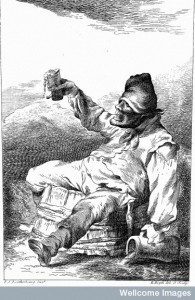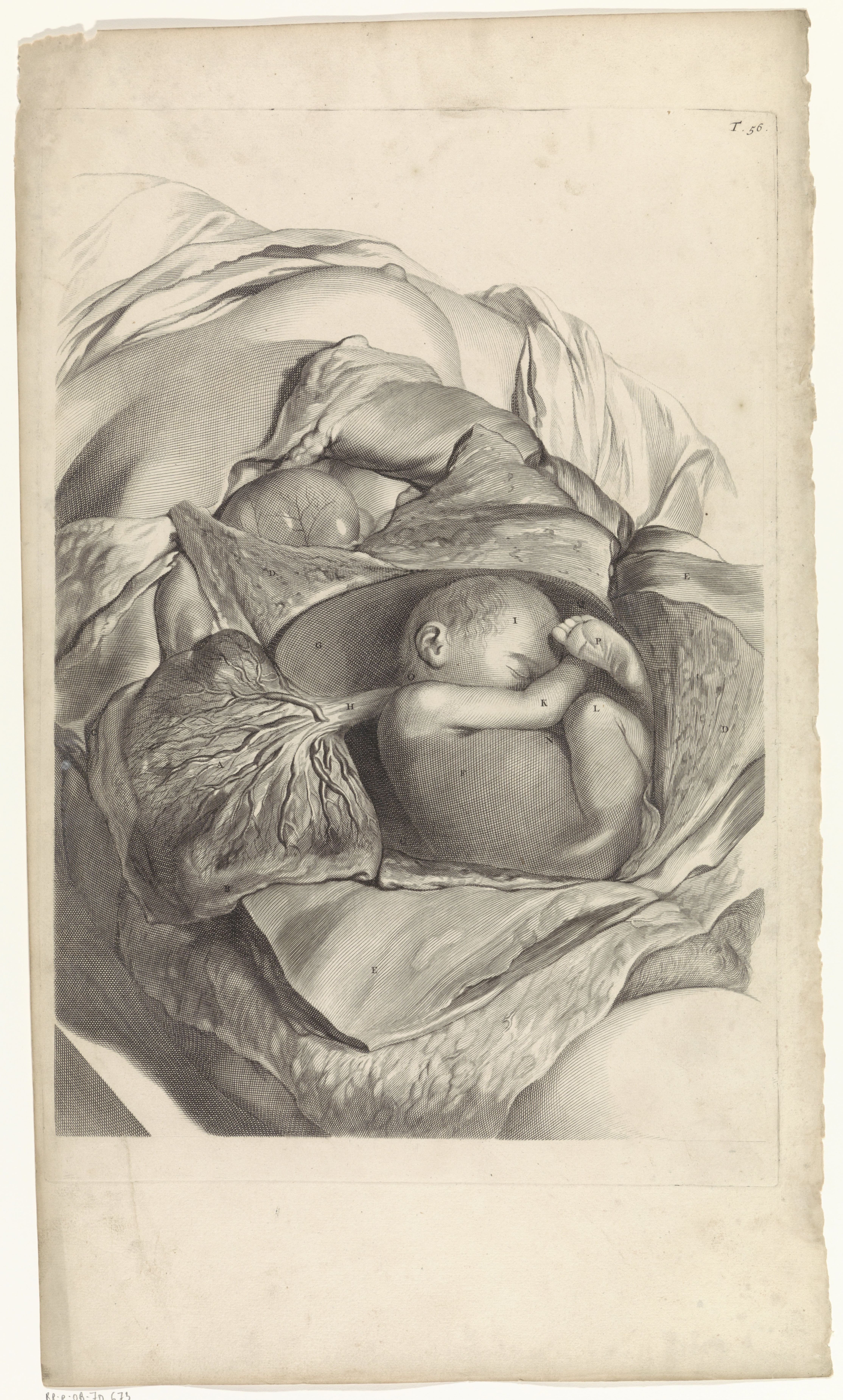

People often say that early modern men and women didn’t drink water because it was dangerous. Medical writers were clearly worried about the safety of drinking water. But it was not just dirt that they feared, but the possibility of swallowing creatures that would then live inside the body.
John Archer’s medical book described the nature of food and drink and how it could affect the body. He claimed, ‘There is a great variety of Waters, all which are cold and moist, but the best is that which is pure and clear, by the sight, taste, smell, and offers the sale of nothing to the tast, nor odour to the smell, which upon the fire is soon made hot, and taken from the Fire doth soon grow cold, which is light, and wherein Flesh and Fruit are soon boyled.’1
The worst type of water, Archer warned, was that found in lakes and marshes, which was thick and crude. This water offended the stomach, obstructed the bowels, and caused pestilential fevers.2 Archer explained that these waters could be ‘corrected’ by boiling, which would cause the dangerous parts to separate out and settle at the bottom.3
The surgeon Paul Barbette offered similar advice for soldiers away on campaign. His main fear though was a little more sensational. He observed that ‘great care is to be had in the choice of water’ and encouraged soldiers to drink ‘clear Water, such as grows warm and cool again sooner than other waters’.4 He also recommended water that ‘run[s] out of stony hills and from under rocks’ as the best.5 At the same time Barbette cautioned against excessive or hasty consumption of beer and wine, in place of water. New beer, he warned, could cause strangury – a disease in which urine was voided painfully by drops accompanied by a stinging or burning sensation.6
Barbette was not worried about dirt and germs, he was concerned about frogs and serpents. He warned that drinking ‘Pit or Ditch-water’ should never be done without first straining the water through some cloth because it could lead to the eventual vomiting of 255 frogs,

Credit: Wellcome Library, London. Wellcome Images
‘least thou shouldst swallow Frog or Snake-spawn. For I have known and had in my cure a Countrey-man, who voided, though not at once but at different times, two hundred fifty and five Frogs, and of them many in my own house, in the presence of divers Ecclesiastical and Secular Persons’.7
As if one off-putting story wasn’t enough Barbette continued, ‘there is a Cook in the Hospital of Wessenburg or Landsberg, who, (as appeared by the event) had drunk the Spawn of Serpents, out of which were bred divers[e] Serpents in his Body, some of which he voided by vertue of the Medicine he took, amongst which there was one of the legnth of a Bavarian Ell.’ Thankfully this unfortunate man was, in the end, described as he ‘hath been since in good health’.8
To prevent such calamities Barbette explained that it was necessary to spread your handkerchief over the ditch-water and drink through that. Alternatively quenching a red-hot stone or iron in the water would make it safe. Finally he suggested that the water should be boiled and cooled and then have some bread put into it which would remove any corruption.
Despite these dire warnings that frogs could breed in the stomach, it was occasionally noted that frogs spawn was a useful remedy. Samuel Hartlib recorded in his ephemerides that a cloth soaked in frogs spawn was beneficial for any accident, hurt or wound:
‘Cloth dipped in frogs sperma
Take Cloth vn-bleached and vnwashen, dipped in March into river where sperma ranarum twice or 3. a day and let it drye and laid vp for all occasions of hurts, wounds etc. For in case any accident befal you, wash the hurt with your owne Pisse, and cut of a smal piece from that cloth and lay it vpon the wound and it will heale infallibly.’
_______
1. John Archer, Every man his own doctor in two parts … (London, 1671), p.81.
2. Ibid, p. 84
3. Ibid, p. 85.
4. Paul Barbette, Thesaurus chirurgiae : the chirurgical and anatomical works of Paul Barbette … composed according to the doctrine of the circulation of the blood, and other new inventions of the moderns (London, 1687), p. 29
5. Ibid p. 30.
6. Ibid, p. 30.
7. Ibid, p. 29.
8. Ibid, p. 29.
© Copyright Jennifer Evans, all rights reserved.




Great post! Ralph Thoresby has some similar tales in an appendix of his history of Leeds: Ducatus Leodensis (1715). He writes of a women who was hot with harvest work, and so drank of the first water she came to which was covered with a green slime, ‘probably the spawn of frogs’. ‘Wherewith she was supposed to be impregnated, having after some time a most cruel gnawing and corroding of her body, of which she died’. The woman’s relations refused to have her dissected so the cause was never proven. But Thoresby goes on to say it is ‘probable’ that frogs and reptiles can be bred in humans, because he has heard of a man that vomited two ‘kitlins’ after eating salads with the sperm upon it, and a maid who ‘voided at the mouth two great Toads, and four small ones, with two small Lizards, all alive’.
Give all the dangers (!) of drinking water, is it right that early moderns rarely did, or is that a myth?
Those are some excellent stories- we may have to add those into the blog post at some point. I can’t quite decide whether they did drink water often or not. I think given all the evidence it is a myth to say they didn’t drink it.
Thanks for this Jen. I used to think that people in the early modern period drank ale and beer on an everyday basis as an alternative to water because they thought water was unsafe – until I came across this post suggesting that water was widely consumed in the period, but beer was preferred as it was something akin to a modern ‘energy drink’:
http://www.slate.com/blogs/quora/2013/05/21/medieval_europe_why_was_water_the_most_popular_drink.html?wpisrc=obnetwork
Clearly there were concerns over the possible health hazards of drinking the wrong sort of water though, as you show, and it is really interesting that there does seem to have been an awareness that some form of boiling would help to treat ‘corruption’. So I guess I am back to seeing the safety issue as at least part of why ale and beer were preferred to water.
That is very similar to what I thought, I think I may have read the same blog. It is a little bit of a conundrum
Water consumption is one of my favourite side projects – I’ve been sitting on a 90% completed article on it for years now 🙁
Anyway, there’s a huge amount of prescriptive literature on what kinds of water to drink, how to fetch it, and hierarchies of the “best” waters to drink as beverage. Must of this comes from, of course, Hippocrates (as David Harley pointed out below) and other ancient & medieval writers.
There is some early modern awareness that boiling is helpful, but I’ve found primarily the use of sand etc. to “filter” out impurities and, of course, collecting & drinking the “pure” rainwater. Moving away from the prescriptive literature, there’s a fair bit of anecdotal evidence (incredibly piecemeal) that some people drank water as a beverage rather than medically.
Mark Jenner would know far more about this.
My impression from diaries is that people might drink water from their own spring or well, but mainly it was boiled and used for small beer, which was the standard drink, even in workhouses.
The mineral content of much well water would make it undesirable as a routine beverage. I have been known to drink my own well water, but generally I use it for washing and cooking. In many parts of the US, that would be a very foolish thing to do.
Obviously, some people were too poor to drink anything other than what was available.for nothing.
Not only spontaneous generation, but also miasmatic exudations were to be avoided.
All good readers of Hippocrates, and all those who knew Airs, Waters and Places at 2nd or 3rd hand, were well aware that one should never consume stagnant water. Running water was the good stuff, from a stream or a spring.
That was why Dr Priestley’s carbonated water was put forward as a prophylactic for scurvy. Especially handy with an infusion of the Peruvian bark, and mixed with some juniper-flavoured distilled spirits, of course. Thank you, Monsieur Schweppe.
The same was true of foetid air, which was why the ventilator of Stephen Hales was put forward as a prophylactic for gaol fever, as also on board ship.
When the drinking of spa waters, as opposed to bathing in them, came into vogue and was interpreted in chemical terms, this was regarded by physicians as highly dangerous. Like the unsupervised immoderate consumption of other active substances, such as drugs or tobacco, it was a sword in a madman’s hand.